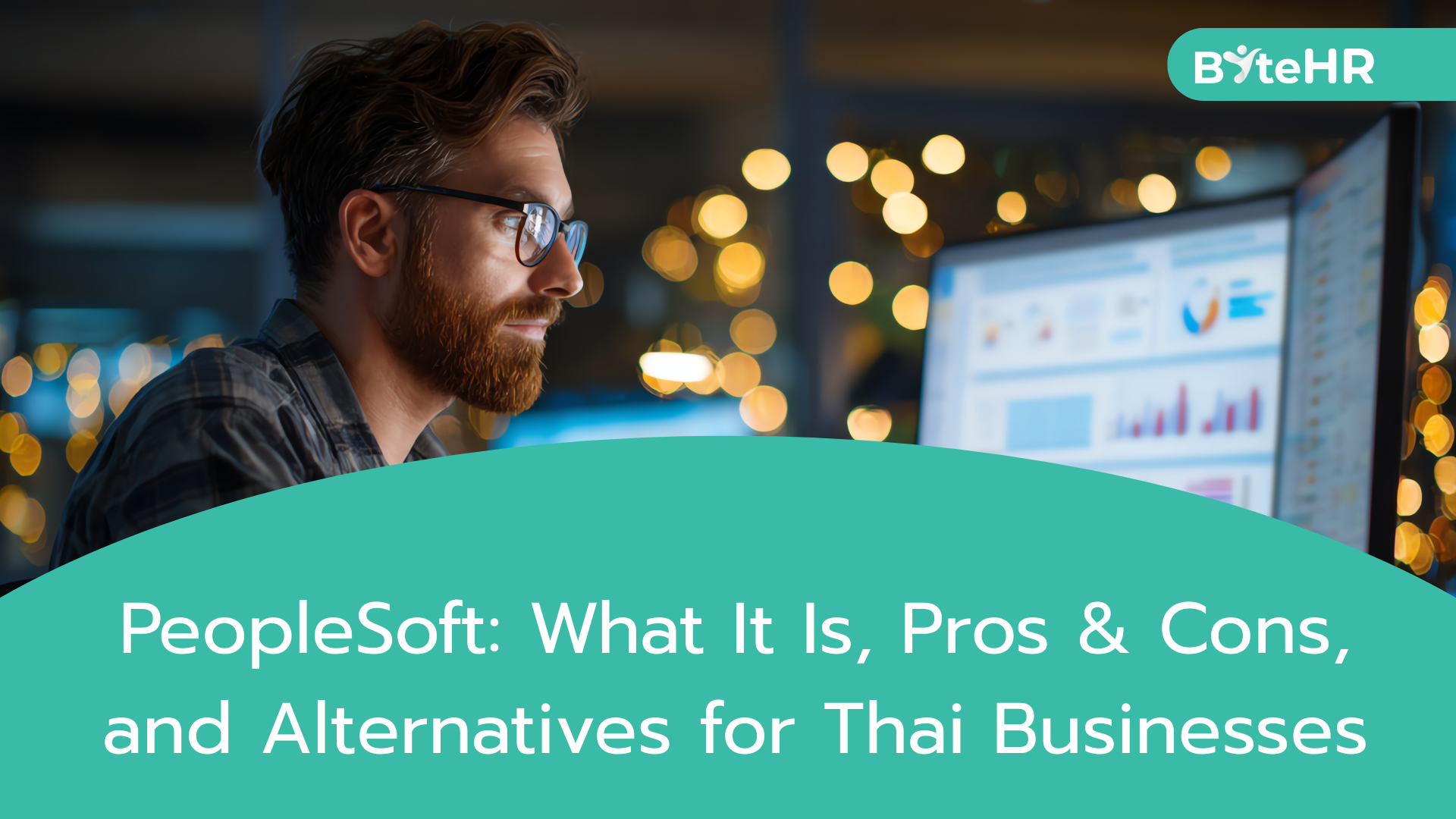PeopleSoft: What It Is, Pros & Cons, and Alternatives for Thai Businesses

In an era where businesses need ERP systems that efficiently manage human resources and finance, PeopleSoft is a name familiar to senior executives. But is this system truly suitable for organizations in Thailand? This article by ByteHR will help you understand PeopleSoft comprehensively, analyzing its pros and cons along with suitable alternatives for Thai businesses.
What is PeopleSoft?
PeopleSoft is an ERP (Enterprise Resource Planning) software founded in 1987 by Dave Duffield and Ken Morris in California, USA. Originally developed specifically for human resources management, it evolved into a comprehensive ERP system over time. In 2005, Oracle acquired PeopleSoft and has continued developing it under the name Oracle PeopleSoft.
PeopleSoft's primary user base consists of medium to large organizations, particularly in government, education, and multinational corporations requiring systems that support complex processes. The system includes core modules covering HCM (Human Capital Management) for managing human resources from recruitment and training to performance evaluation, Payroll for managing salaries and employee benefits, Financials for accounting and finance, Supply Chain Management, and Campus Solutions for educational institutions.
PeopleSoft's Strengths
PeopleSoft's distinctiveness lies in the depth of functionality covering all dimensions of human resources and financial management. The system is designed to support complex processes such as multi-structure payroll calculations, diverse benefits management, or long-term human resource planning, making it suitable for organizations with complex structures and requirements.
Customization capability is another significant strength. PeopleSoft uses PeopleTools, which allows organizations to modify screens, forms, and workflows according to specific needs without having to alter the Core Code, making future upgrades easier.
For large organizations operating across multiple countries, PeopleSoft supports multiple currencies, languages, and tax regulations in a single package, enabling management of employees and finances globally from one system. Additionally, the system is highly stable and has been developed for over 30 years, earning trust from many leading organizations.
Common Limitations
Despite numerous strengths, PeopleSoft has limitations organizations should consider. The first issue is the high Total Cost of Ownership (TCO). Not only are license fees expensive, but costs also include installation, customization, training, and maintenance requiring specialized IT teams.
System updates and upgrades present another challenge. Although Oracle releases updates regularly, actual implementation requires significant time and resources, especially if the organization has extensive system customizations. Planning and testing before upgrades is time-consuming and necessary.
User Experience (UX) and mobile device compatibility represent another weakness. PeopleSoft's interface was designed long ago and may appear outdated compared to modern Cloud-native systems. Despite UI improvements in PeopleSoft 9.2, mobile experience still doesn't match modern applications.
Finally, there's the Vendor Lock-in problem. Once an organization has invested in PeopleSoft for some time, migrating to another system becomes very costly, including data migration, retraining employees, and losing customized processes.

Challenges in the Thai Context
When implementing PeopleSoft in Thailand, organizations encounter several significant specific challenges. The first issue is calculating withholding tax and PND.1 forms, which have frequently changing and complex regulations, such as calculating various tax deductions, electronic filing, and monthly tax reports that must be submitted to the Revenue Department.
Thailand's social security system is complex in contribution calculations, filing SPO.1-10 forms, and integrating with the Social Security Office's system. Standard PeopleSoft may not directly support these processes, requiring customization or supplementary modules.
Thai-language documents and payslips are legally required, necessitating correct Thai language display, including deductions and additions that employees can easily understand. The system must support Thai printing and document formatting according to standards used in Thailand.
The Personal Data Protection Act (PDPA) now in effect requires organizations to manage employee data carefully. Systems must control data access, obtain consent, and delete data upon employment termination, requiring PeopleSoft to be configured in compliance with this law.
Leave and approval workflows in Thailand have specific characteristics, such as sick leave, personal leave, annual leave, maternity leave, and Thai traditional holidays. Systems must support leave accumulation, remaining leave calculations, and approval processes that may have multiple levels according to organizational structure.
PeopleSoft Alternatives in Thailand
For organizations considering alternatives beyond PeopleSoft, the following criteria should be used for evaluation:
Localization is the most critical factor. The system should directly support Thai tax calculations, social security, and Thai labor laws without extensive customization. It should have ready-to-use Thai report templates and update according to changing regulations.
Support and service in Thailand are essential. There should be local teams understanding Thai business context, able to provide consultation and solve problems quickly, including documentation and training in Thai.
Product Roadmap from the developer should be clear, especially the direction of feature development for the Southeast Asian market. Updates should be regular with new functions addressing modern business needs.
Pricing model and seat count should be flexible and appropriate for organization size. Cloud-based SaaS systems typically have lower initial costs and easier scalability, suitable for mid-sized organizations wanting to control expenses.
Data migration process is an often-overlooked factor. Choose systems with tools or services to help migrate data from Legacy Systems, including APIs that easily connect with other systems. Providers should have experience migrating data from various systems and be able to accurately assess complexity and timeline.

Conclusion
Choosing an ERP system is a long-term investment affecting organizational operations. Therefore, carefully evaluate both current and future needs, compare alternatives objectively, and select the system most suitable for the Thai business context.
Want to stay informed about tax regulations, tips for employees and employers, and HR best practices? Follow ByteHR's blog for regular updates. If you're considering a new HR system but aren't sure where to start or whether specific features will meet your company's needs, contact ByteHR for a free consultation at 02 026 3297 or email sales@byte-hr.com.


